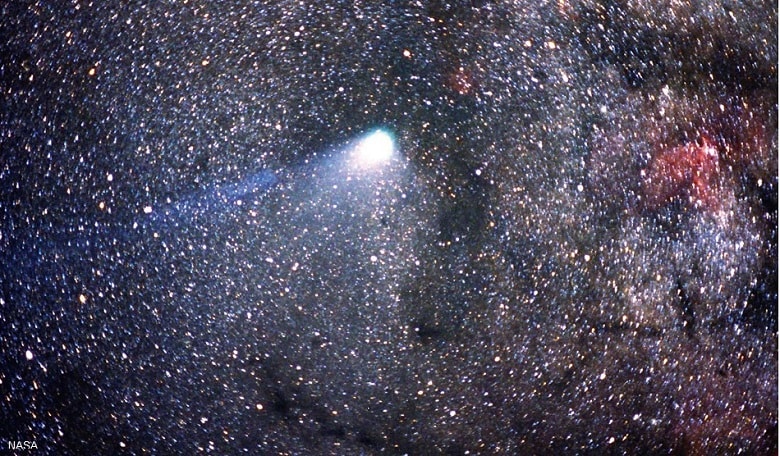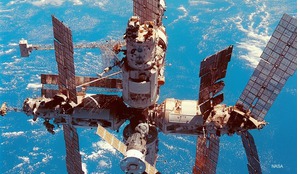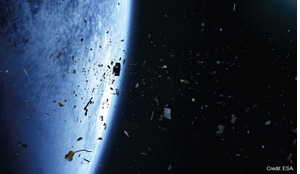The USSR’s first project in solar system small body research was the encounter with Halley’s Comet and its study at relatively close distances. The comet’s 76-year-long orbit passes through the centre of our solar system.
Prior to this, the USSR considered a joint Venus research project with France, where Venus would be observed from an orbital vehicle and from a balloon aerostat floating in Venus’ cloud layer.
The project was called Venus-Eos. The planned date of the probe’s approach to Venus was close to the date Halley’s comet was supposed to pass by Venus. It was possible to correct the probe’s path so that, after passing by Venus, its trajectory would intersect with the comet.
Perhaps it was these factors, along with some academician Roald Sagdeyev in 1984, to abort the Venus-Eos mission and lobby for the new Vega mission, to be launched in 1986.
Both countries had already invested significant sums into the Venus-Eos project. The decision was not an easy one, but as history proved, it was the correct one. The new project was named VeGa,an abbreviation of Venus and Halley (pronounced “Galley” in Russian).
At first, the French were vehemently opposed to this decision. Their initial refusal to participate in the new project was what led to the birth of our Planet Research Small Vehicles Laboratory.
Halley’s comet and Venus
There wasn’t much time to intersect with Halley’s comet – after a short while it would once again move far away from the Sun and return only in another 76 years. Venus, on the other hand, could be explored quite frequently.
Our technical specialists showed that they were capable of adapting the probe and sending it to meet Halley’s comet after it flew by Venus and its landing module and small probe had detached. The issue was getting the French side to agree to the project changes.
Sagdeyev was so convincing, that in the end both sides (USSR and France) agreed to modify the project and to meet up with Halley’s comet after flying by Venus.
The French group that remained on the project was headed by the famous J. Blaumont. It was responsible for international cooperation in calculating the balloon aerostat’s coordinates and speed in the atmosphere, using the radio interferometry method with a large database and preparing to take atmospheric pressure measurements at the height the balloon aerostat was located. It was entirely due to J. Blaumont’s reputation and authority that the balloon aerostat experiment remained part of Vega project.
The Vega project made USSR space research open and available to the scientific community
The purpose of the balloon aerostat was to research superrotation and its supporting mechanisms. The Soviet side was entirely responsible for its development. Our grouphandled this task with great enthusiasm.
A race for signals
The engagement of an international network of aerostat signal reception stations created a spirit of sportsmanship. When the balloon aerostats entered Venus’ atmosphere, operators on many receiving stations waited anxiously to catch their signals.
A competition began between Russian and American specialists as to who would be the first to receive the aerostat signal. The Americans were the first to receive the signal. We received it a few hours later, which was first and foremost due to the fact that Venus was visible from the USSR at a later time.
But American specialists could not decipher the received data. We remember how we feverishly raced to process the information we’d obtained. We were able to decipher it first and see the first data on Venus’ atmosphere received from the aerostats. Of course we were glad to share this with the Americans.
Phobos, pictured here in 2008, has fascinated scientists for decades. Soviet scientists were no exception
Perhaps the fact that the Russians were the first to decipher the data, even though they had received it much later, pushed the Americans to be more proactive. Four hours later they confirmed that they had gotten the information out of the signal. This peaceful international competition and our small victory won us the respect of our colleagues from across the ocean.
Vega and Giotto cooperation
At the same time as Vega was being developed, the European Space Agency was working on its own project, Giotto, the goal of which was to fly by Halley’s comet nucleus.
The Vega spacecraft was supposed to pass Halley’s comet before the Giotto craft. And thus an idea appeared – to specify the parameters of the comet’s orbit, taking into account the orbit of the Vega craft and using data it gathered on the comet’s location, and send these precise orbital parameters to the European Space Agency.
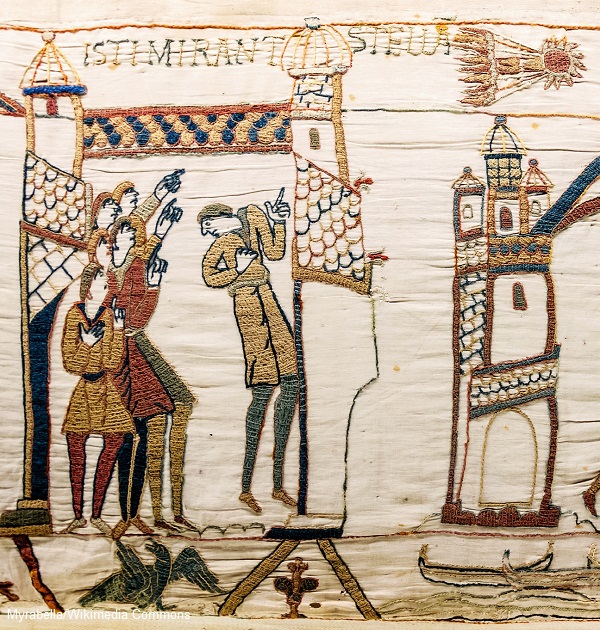 Humanity’s fascination with Halley’s comet has, meanwhile, gone on for centuries. Here it is pictured in the Bayeux Tapestry all the way back in 1066
Humanity’s fascination with Halley’s comet has, meanwhile, gone on for centuries. Here it is pictured in the Bayeux Tapestry all the way back in 1066
The cooperation between the space agencies was successful, and the Giotto craft obtained more precise orbital parameters of the comet.
For Russia, launching Western spacecraft does not help develop new technology
The Vega project therefore took another fundamentally new step in USSR’s space research: it became open and available to the wider scientific community.
Exploring Phobos
After the brilliant results of the Vega project, Soviet scientists and engineers were enthusiastic about working on their next project, one no less ambitious than Vega.
The project’s main goal was Phobos, one of Mars’ moons. The launch was planned for 1988. There were interesting questions about Phobos’ origins, of whether or not it was a captured asteroid.
The project was first suggested by the Institute of Applied Mathematics (IAM) and the Institute of Geo- and Analytical Chemistry (IGAC). But during its development it moved under Institute of Space Exploration (ISE) management, as ISE had a betterprepared base for experiments. Therefore they conducted many of the necessary experiments on the project.
The spacecraft was supposed to go into Phobos’ orbit and then land on Phobos itself. But during project development it became clear that it was easier to measure Phobos’ chemical and mineralogical composition from a low orbit distance of about 50 meters.
ISE suggested the use of a laser gun, to shoot at Phobos’ surface in order to analyse the atoms and ions that would fly out, on board the satellite in orbit. Only the standalone small station (SSS) would then land on Phobos. The station would take precise measurements of Phobos’ orbit parameters and its vibrations, and explore its internal composition. It was intended that the consistency of the gravitational constant in relation to the law of universal gravitation would also be measured.
The experiment was planned by cooperating teams of scientists from the USSR, the US and France. But a standalone station on Phobos’ surface that could precisely measure the distance, speed and angle coordinates using the largebase radio interferometry method was needed. Our lab prepared this experiment as part of the project, working together with our colleagues from Lavochkin RDC, the Research Institute for Instrumentation and French specialists. We created and tested the spacecraft and all of its equipment.
Running into bad luck
This project was unlucky from the very beginning. Not long before the planned launch date, a problem was discovered with one of the types of radioelectronic equipment components with a large volume electrolytic condenser. The problem only appeared after such components had been stored for a while, which is why it wasn’t discovered earlier. And these components had been used in various instruments! There was no time to replace them at that point.
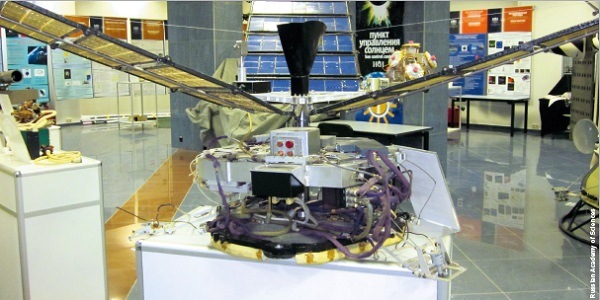 A full-scale model of the standalone small station (SSS) with deployed solar panels. It was developed for the Phobos mission
A full-scale model of the standalone small station (SSS) with deployed solar panels. It was developed for the Phobos mission
One of the possible solutions was to delay the launch until the next astronomical window of flight to Mars (i.e. for two years), and use that time to replace the suspect components. Or, we could proceed on schedule and hope that the triple back-ups on all of the important blocks of all service equipment would be sufficient. Besides, two spacecraft had already been launched in the Mars project in 1988. One craft was lost in the beginning stage of the flight due to a command error that was given when it was already on its way to Mars. Another spacecraft remained, along with the faith in service equipment back-ups.
The remaining spacecraft successfully made it to Mars in January of 1989 and went into Mars’ orbit. It took a series of measurements of Mars’ surface characteristics, moved into orbit close to Phobos’ orbit, took measurements that were unique at the time and filmed Phobos’ surface for a period of two months. It was about to start moving in closer to Phobos.
Considering the loss of one spacecraft, someone in management felt that it was necessary to review the running operation program for Mars’ orbit and have the SSS land on Phobos’ surface before schedule. This was a very reasonable idea.
Our laboratory was asked if this could be done We said yes.
Yet this sensible idea was turned down by management. And two days before the SSS was supposed to land, there was a breakdown due to the electrolytic condenser problem. The enormous effort invested by many people was destroyed by a single wrong decision.
Space is like a minefield – one mistake, and every one of the project’s participants feels empty inside. Why didn’t the triple back-ups work? The question remains unanswered. Though for a number of years the results obtained by that spacecraft were unique in the study of Phobos and Mars.
Fun with Mars rover
As a result of the polemic on the information obtained by the Phobos spacecraft, most of the researchers at ISS spoke out in support of further Mars exploration. A lot of effort was invested in developing a Mars rover that would be able to cover long distances.
Our laboratory, together with the Transport Engineering Research and Development Institute (TERDI), created a Mars rover prototype, which underwent extensive testing from Kamchatka to California’s Death Valley (with support from the American Planetary Society).
We were joined by a large group of American enthusiasts on all of our experiments in California. Widespread interest in our work attracted the attention of NASA’s chief administrator Dan Goldin. He even came out to see what the Russians brought.
We tested the equipment’s working efficiency prior to traveling out into the desert for testing. At the request of Louis Friedman, executive director of The Planetary Society, we held an exhibition performance for Goldin. We created various obstacles for the Mars rover and set it free in the model range. The rover easily overcame obstacles, some of which were as tall as it was.
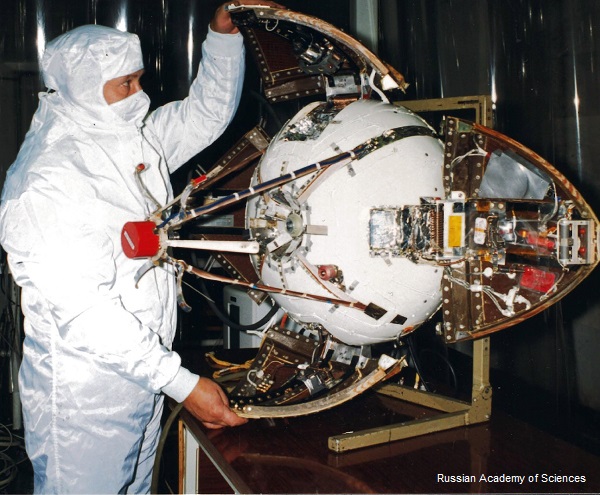 The standalone small station meant for Phobos was put together at the Lavochkin Scientific Production Organisation
The standalone small station meant for Phobos was put together at the Lavochkin Scientific Production Organisation
One obstacle remained, with an almost vertical wall that we had created out of a large table. And suddenly, something unexpected happened. The Mars rover started moving directly onto the nearly vertical wall and got on its hind wheels, much like a dog. Everyone thought it would fall.
Everyone, including Goldin, was ready to run over and save the rover. But it stopped, thought for a second, and, quite business-like, began to climb back down. It got down, drove a little bit to the side of the table, and then began to drive around it.
The collapse of the USSR, which affected the space program, had unfortunately gotten in the way of this interesting project. The Martian program, and the subsequent Phobos exploration program, which was supposed to deliver soil specimens from the moon’s surface back to earth, both failed to come to fruition.
Baikonur plunges into darkness
We’d like to share an example of the conditions we had to work in back then. For instance, the story of the final stage of the last Baikonur USSR mission in 1996. There was no USSR anymore, but there was still a mission.
We lit some candles. Good thing the telephone was still working
We remember how the craft was assembled in the assembly shop. Some flaws were discovered during assembly that had to be fixed right away. In only two days the craft had to be mated with the upper-stage rocket, and then with the launch vehicle. Everyone was rushing, but many of us understood that there wouldn’t be any missions after this one any time soon, and that made us work more conscientiously.
On the last night, when we had to join the spacecraft with the upper-stage rocket, the lights went out at 1 a.m. Everyone gathered in the office of Alexey Nikolayevich Korolev, the project manager. We lit some candles. Good thing the telephone was still working.
We started calling the Baikonur power station. We remember the voice of the officer on duty as if it were yesterday. “What do you want?” Alexey Nikolayevich explained that we were preparing the Mars-96 spacecraft, that it’s an international project and that we need light. We heard a lazy, sleepy voice: “I don’t know any Mars-96, I’ve got nothing written down here and you’re not supposed to be there, and we should be saving energy anyways, there isn’t enough of it at Baikonur these days.”
All attempts to contact higher authorities at Baikonur were in vain. The spacecraft had to be ready by morning, ready to be sent out to join the upper-stage rocket. It was a dead end.
Then, someone suggested that we call Moscow and bring in the heavy artillery, the President of the Academy of Sciences. Maybe he could do something.
We managed to reach him, though not right away. Alexey Nikolayevich explained the problem.
We remember those difficult hours of waiting by candlelight, the tense faces all around. Four hours later – the phone rang. And the officer’s voice this time was quite wide-awake as he yelled: “Is this area 31, are you the ones who need the lights on?”
We all nodded, in unison, but silently. Alexey Nikolayevich said “yes!” out loud.
“Will turn them on shortly!” – We heard back.
Only later on did we find out, that the President of the Academy was able to reach the Defence Minister in the middle of the night, and at 3 a.m. he explained our problem and convinced him to help. In turn, the Defence Minister woke up the director of Baikonur and apparently explained in no uncertain terms that what was happening wasn’t very nice.
Perhaps that’s why the officer on duty, who only hours earlier tried telling us that we were impostors and trespassers, sounded so alert when he called back.
‘Ruin starts in our heads’
As professor Preobrazhensky said in Mikhail Bulgakov’s Heart of a Dog: “Ruin starts in our heads.” Talented designers, mathematicians, scientists were forced to leave this industry and either work in private business, or leave the country altogether. And fundamental space exploration halted for decades to come.
During the era of active space exploration programs in the USSR, the US and Europe wanted to participate in our projects and in turn invited Soviet scientists to work on NASA projects. Now, Russia must provide launch vehicles for European projects for the chance to participate in just one or two experiments, or to install its own equipment on Venus’ or Mars’ orbital satellite. It should be understood that launching Western spacecraft does not help develop technology for new spacecraft, or variable purpose landing modules (including those meant for scientific research), and in turn only leads to the gradual degradation of the existing ones.
Russia has lost an entire generation of talent. Much must be rebuilt from the ground up.
During the previous research period, Russian engineers and scientists have learned how to make lighter and more compact space technology both for research instruments and functional purposes. This progress is mostly due to the miniaturization of all electronic components.
The research goals for small spacecraft are quite interesting. The cost of projects that use small spacecraft is significantly smaller. The first project that used the base we created was the Sun Sail, launched in 2004.
We got the funding for this project from the American Planetary Society. Considering the scale of the project, the sum was minuscule – about 4.5 million dollars (when the project should have had the budget of 50-60 million dollars). But the “ruin in the heads” has gotten to the point where even military launch vehicles were failing due to simple lack of routine maintenance. Two launches and two failures. The search for new financing went on for eight years and was unsuccessful.
Hopes for the future
In recent years, we have been working together with the National Institute for Space Research (Brazil, INPE), on a joint project with the use of small spacecraft. Cooperation was made possible thanks to former ISE employee A.A. Sukhanov, who currently works at INPE. ISE suggested discussing the possibility of a small spacecraft joint project. The goal of the project is to fly to the Trojan asteroids for exploration.
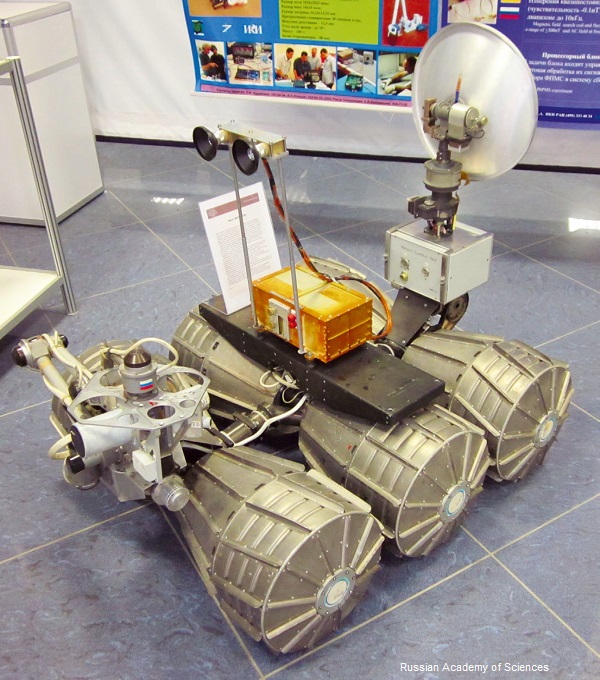 Our Mars rover ended up putting on quite a performance in Death Valley. But the collapse of the USSR was its death sentence
Our Mars rover ended up putting on quite a performance in Death Valley. But the collapse of the USSR was its death sentence
Russia has lost an entire generation of talented engineers, designers, and mathematicians
The chosen asteroid is composed of three gravitationally-connected objects. The goal is to fly up to these objects, obtain high definition photographs, and measure the chemical composition. A joint group evaluated the spacecraft’s characteristics, navigation requirements and experiment packet structure. The total mass going into near-Earth orbit is only about 150 kg.
There is tentative hope that the project will proceed. If this does happen, it will be a new direction of exploration, pioneering work even compared to other international missions. It will be the first far-flying mission project in the world conducted by independent institutes. Miniature navigational instruments and electric propulsion engines are the key components of the project. Russian engineers and technicians have experience in creating and using such components in space.





